Introduction
The Posidonia Shale of Southern Germany has been known for several centuries for its excellently preserved fossils (e.g., Quenstedt 1885; Hauff & Hauff 1981; Riegraf et al. 1984; Urlichs et al. 1994). Faunal content, sedimentary structures and the high amount of organic matter indicate oxygen deficiency and very calm depositional conditions (e.g., Seilacher 1982, 1990; Röhl et al. 2001; Schmid-Röhl et al. 2002). Generally, benthic life was rare and, if present, limited to a few adaptable species. The bituminous marls were deposited over about 3 million years in a shallow basin, a marginal sea of the Tethys. Due to the multitude of research methods used in the past, a thoroughly dynamic overall picture of the ecosystem with recurring, relatively short phases allowing benthic colonization is emerging (Röhl et al. 2001).
The dark gray rock sequence of the 180 Ma Posidonia Shale Formation is in the foothills of the Swabian Alb (Fig. 2). There, the cement factory and Fossil Museum owned by Holcim (Süddeutschland) GmbH, is located in the small village of Dotternhausen. Active rock mining of the Posidonia Shale currently occurs close to the neighboring village of Dormettingen. Dotternhausen and Dormettingen are situated between Balingen and Rottweil, about 80 km southwest of Stuttgart. There the total thickness of the Posidonia Shale Formation is about 12 m.
Fossils and Paleoenvironment
Fossils
Completely preserved vertebrate finds are rare in the fossil record. Therefore, a Fossillagerstätte like the Posidonia Shale is of outstanding importance for paleontology. Numerous excellently preserved skeletons of fish, ichthyosaurs and rarer finds of crocodiles and pterosaurs could be recovered in Southern Germany, especially in the Holzmaden area but also in Dotternhausen and Dormettingen. Extraordinary ichthyosaur skeletons – some of which even show soft tissue preservation – were found in the dark bituminous clay- and marlstones of the Posidonia Shale (Fig. 1). It is all the more astonishing that, after such a long time of intensive collecting and research, new discoveries are being made again and again, providing new pieces of the puzzle for understanding the former ecosystem. In recent years, scientists described two new vertebrate species from the Posidonia Shale of Dotternhausen: the shark species Crassodus reifi (Maisch & Matzke 2016) and recently the ichthyosaur species Hauffiopteryx altera (Maxwell & Cortés 2020).
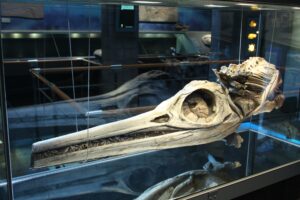
Figure 1. Skull of the ichthyosaur Temnodontosaurus trigonodon found in the Posidonia Shale of Dotternhausen (length: 1,12m). Werkforum and Fossil Museum Dotternhausen, FWD_0130.
Among the most common macro-invertebrates of the Posidonia Shale are bivalves, ammonites and belemnites. They often occur in high abundance but low diversity indicating an environment with poor living conditions. At first sight, the often badly preserved bivalve shells and imprints appear unspectacular. The individuals are mostly inconspicuously small, yet they are of crucial importance for the interpretation of living conditions (Röhl et al. 2001; Schmid-Röhl & Röhl 2003). The bivalve Posidonia (today Bositra) gave its name to the dark clayey marlstones, but there are still many uncertainties about its way of life. Bositra occurs repeatedly in masses in certain strata. The small shells with up to 20,000 individuals/m2 lie close together. For a long time, the way of life of Bositra was controversial. Interdisciplinary studies show that Bositra had a bottom-related way of life and was able to colonize the seafloor quickly and at high density.
In general, ammonites are very common in the Posidonia Shale. The most abundant genera are Dactylioceras, Harpoceras, Hildoceras, Lytoceras and Phylloceras. After the death of the ammonite the shells were dissolved and compressed during compaction of the clayey sediment. Only the thin pyritized periostracum is preserved and gives the ammonites their pretty golden-brownish color. Belemnites are abundant in certain strata of the sequence but are absent in the lower part of the black shale facies. They seem to have had a more bottom-related way of life, as they are mostly absent in layers with very high organic carbon content. On layers with accumulations of numerous belemnite rostra they can serve for the reconstruction of paleocurrents.
Paleoenvironments
The Posidonia Shale has been the subject of intense scientific investigation for 400 years. Since 1900, questions concerning the depositional conditions and ecology during the Early Jurassic became the focus of interest. To explain the formation of the rocks, comparisons were made with modern ecosystems, such as the Black Sea or the Baltic Sea. Various studies could prove that oxygen availability in the Posidonia Shale Sea was subject to strong fluctuations. Phases of benthic colonization alternated with anoxic or even euxinic conditions. Both colonization on elevated benthic islands (Kauffman 1978, 1981) and a pseudoplanktonic way of life (Seilacher 1980, Matze & Maisch 2019) were "survival strategies" in the ecosystem of the Posidonia Shale Sea.
Changes in oxygen content in the benthic environment of the Posidonia Shale can be explained by climatic changes. During the Early Jurassic, the subtropical location of Central Europe, a high sea level, a warm balanced greenhouse climate with mild water temperatures and a seasonally changing mega-monsoon influenced the environmental conditions. When the bituminous sediments were deposited, southwest Germany was located at about 30° northern latitude, which corresponds roughly to the current latitude of cities like Cairo or New Orleans. The position of the continents and the existence of the huge continental mass Pangaea led to a special paleoclimatic situation. The resulting wind systems, which were strongly seasonal, were mega-monsoons. They influenced the circulation in the sea basin by changing sedimentation rate, nutrient input and evaporation rates.
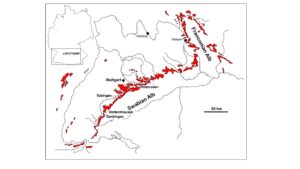
Figure 2. Locality map and outcrop of the Lower Jurassic Posidonia Shale (in red). Dotternhauseen und Dormettingen are located in the foothills of the Swabian Alb escarpment.
Geological and Paleontological Heritage
Research History and Economic Use
Interest in the dark and bituminous shales dates back for several centuries. In 1847, Friedrich August Quenstedt (1809–1889), the famous geoscientist and founder of the Department of Geology and Paleontology of Tübingen University, was assigned to investigate the organic matter content of the Swabian Posidonia Shale from an economic point of view. For a short time, the rocks were mined for crude oil production near Reutlingen.
During World War II, the “Wüste Operation” of the Nazi terror regime started. They forced laborers of several concentration camps to mine the rocks and to extract fuels for their machinery of war. Many lost their lives due to incredibly hard work and degrading conditions. These terrible crimes are documented in the Balingen area by memorials, cemeteries, information trails and a history museum, which remind us of this dark period of history (e.g., Bisingen, Dormettingen, Schömberg).
The Posidonia Shale is a world-famous Fossillagerstätte (Urlichs et al. 1994). The first fossils were recorded in 1598 by the medical doctor Johannes Bauhin. He interpreted ammonites as “metallic things” in rocks and as “miraculous tricks” of nature. Later, fossil crinoids were viewed as being huge flowers or interpreted as heads of Medusa – a victim of the flood – to prove the biblical story. Many people did important geological and paleontological research on the Swabian Posidonia Shale, including Carl Hartwig von Zieten (1785–1846), Eberhard Fraas (1862–1915), Bernhard Hauff senior (1866–1950) and Adolf Seilacher (1925–2014).
In Dotternhausen, in 1939 Rudolf Rohrbach founded a cement plant to produce a unique cement using burnt Posidonia Shale as a supplement. As he was very interested in fossils and earth history, many fossils found in the quarries were carefully recovered and excellently prepared by his own staff. In 1989, he built the company-owned Fossil Museum and Werkforum, located at the cement plant in Dotternhausen, to show some of the most beautiful fossil treasures to the public. Since 2005, the cement plant and the museum belong to the Holcim (Süddeutschland) GmbH.
The Fossil Museum of Dotternhausen
The company-owned Fossil Museum is one of the information points and geosites of the UNESCO Global Geopark Swabian Alb and shows an outstanding collection of fossils from the Posidonia Shale (Jäger 2005). The museum displays fossils from the company's own quarries in an unusual ambience and timeless architecture, with the focus on Posidonia Shale fossils (Fig. 3). However, the permanent exhibition provides also a vivid overview of the living world of all the Jurassic. For decades, many groups of university students have visited the museum and the quarries as part of their geoscientific education (Fig. 4). Numerous school classes, tourists and hobby paleontologists are also guests at the Werkforum. Between 12,000 and 20,000 people visit the Fossil Museum each year. Visits to the museum are free of charge. A special attraction is the “fossil discovery site” outside the building, near the entrance of the museum, filled with fresh oil shale from the nearby quarry. Visitors can go there for fossil hunting with hammer and chisel (Fig. 5). An important aspect of the educational work is to inform visitors that fossils are heritage protected and special finds must be reported.
Mining in the company's own quarries provides ideal conditions for access to fresh rock material for research to pursue a wide range of geoscientific questions, including e.g. paleontological, paleoecological, stratigraphic, sedimentological and isotope geochemical investigations. Due to its high organic matter content (up to 20 %) the Posidonia Shale also offers an interesting field of research in organic geochemistry, such as biomarker analysis, the search for “geochemical fossils”.
This variety of earth sciences research fields means that the Posidonia Shale can help to answer many research questions and represents a unique window into Earth history. The mining and use of this special and fossil-rich raw material thus entails a responsibility towards science and the public. For more than 30 years, the Fossil Museum in Dotternhausen has been fulfilling this educational mission in a variety of ways, offering guided tours, a children's program, teacher training and student excursions.
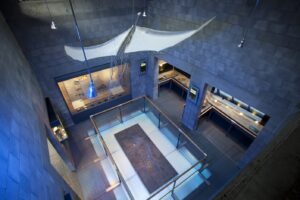
Figure 3. The Werkforum displays a remarkable Jurassic fossil collection in an outstanding ambiance in the company-owned museum incorporated into the Holcim cement plant of Dotternhausen.
The site is popular among researchers, geology students, and the wider public. Extracurricular learning plays an important role in geoscientific educational work, since such teaching is only a small or non-existent part of school lessons. The Fossil Museum offers advanced training for teachers on the subjects of geology, raw materials and earth history. Environmental education projects, some in cooperation with local environmental institutions, are part of the summer holiday program "Holidays in the Jurassic Sea", which was awarded the UN Decade Project in 2018 and 2020. A regular children's program, which teaches geoscientific topics in a playful way, has been part of the calendar of events since 2014. Regular exhibitions on geological/paleontological topics are held in the museum's temporary exhibition, always opened by a lecture from a scientist or specialist.

Figure 4. As part of their university education or for research purposes, students and scientists visit the active mining site in Dormettingen. On guided tours they have the possibility of studying the sediment, collecting fossils and taking samples.
Regional fossil collectors present their fossil finds each year at their exhibition. Spectacular and innovative exhibitions, such as the traveling exhibition “Rock Fossils” are presented in the Werkforum (www.rock-fossils.com). In this way, it is possible to arouse the interest of new target groups for geological topics. The Posidonia Shale offers a unique opportunity for interdisciplinary learning: historical, geological and paleontological topics can be combined. The Werkforum provides a link from the cement plant to the public and has been part of the company's philosophy since more than 30 years.
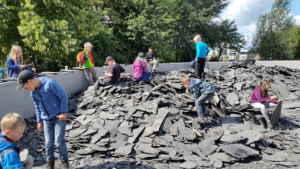
Figure 5. The “fossil discovery site” near the entrance of the museum offers the opportunity to families and hobby palaeontologists to find fossils on their own.
SchieferErlebnis Park in Dormettingen – from an industrial quarry to a tourist highlight
Quite different opinions had to be brought together when, after the closure of oil shale quarry, the community of Dormettingen, the Holcim (Süddeutschland) GmbH, landscape architects, interest groups, nature conservation and authorities started to discuss the future of the former quarry. The result is really outstanding: since 2015 rewilding combined with interaction, entertainment, communication and experience of nature and earth history attract school classes, local residents as well as tourists (Fig. 6). A unique park landscape was created, where the oil shale topic is shown in all its facets: earth and landscape history, geology and paleontology, exploitation of natural resources as well as rewilding and biodiversity. The tales told here start with the fossils of the Jurassic Ocean and reach the recent flora and fauna. Since 2017, the SchieferErlebnis Park has been a geopoint in the Swabian Alb Geopark.
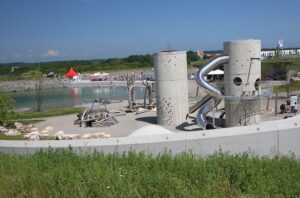
Figure 6. The SchieferErlebnis Park of Dormettingen, a recultivated quarry imparts to the visitors how closely interrelated industrial history, geology, paleontology, biodiversity, mankind and nature are.
Conclusions
The Posidonia Shale is an extraordinary fossil deposit with a long scientific history and tradition in fossil collecting and offers a great potential to convey the history of the Jurassic period in a lively way. Due to its fossil richness, the dark rocks inspire researchers as well as hobby paleontologists and children. Despite centuries of research, there are still open questions why the Posidonia Shale remains part of different geoscientific disciplines. The large amount of data and knowledge that has been gained especially in the quarries of the Posidonia Shale of Dotternhausen during the last decades means that the rock sequence has become a kind of reference profile on which new research methods can be calibrated.
The Posidonia Shale also enables interdisciplinary learning (e.g., history, geology, paleontology, raw material science, rewilding, geochemistry). The rock is particularly suitable for arousing interest in various geoscientific aspects (e.g., Maisenbacher 1993). The Fossil Museum of Dotternhausen and the SchieferErlebnis Park of Dormettingen are, together with the Hauff Museum of Holzmaden and the Paleontological Museums of Tübingen University and Stuttgart (State Museum of Natural History) of outstanding importance to preserve the unique geological heritage from the Jurassic period and to make their fossil treasures accessible to the general public.
